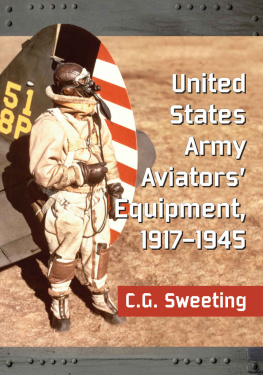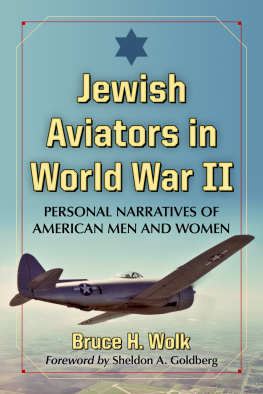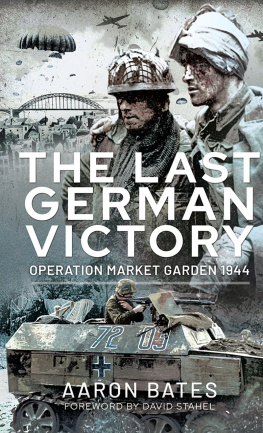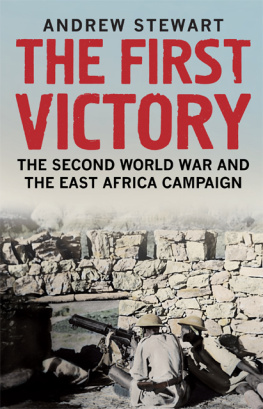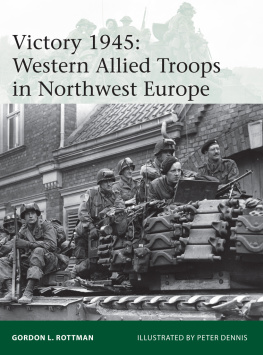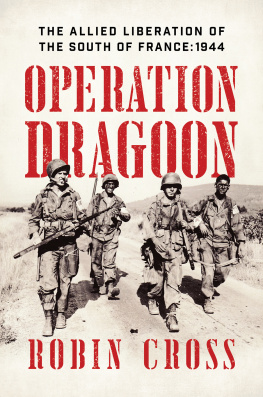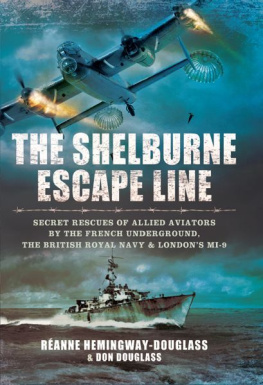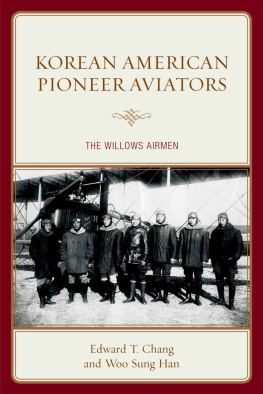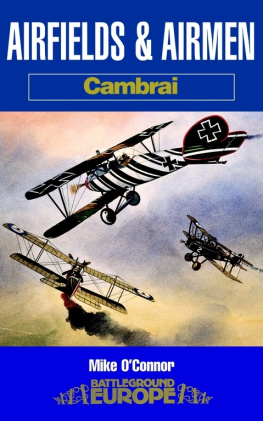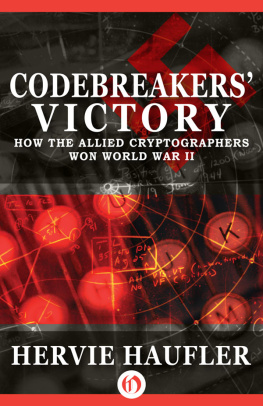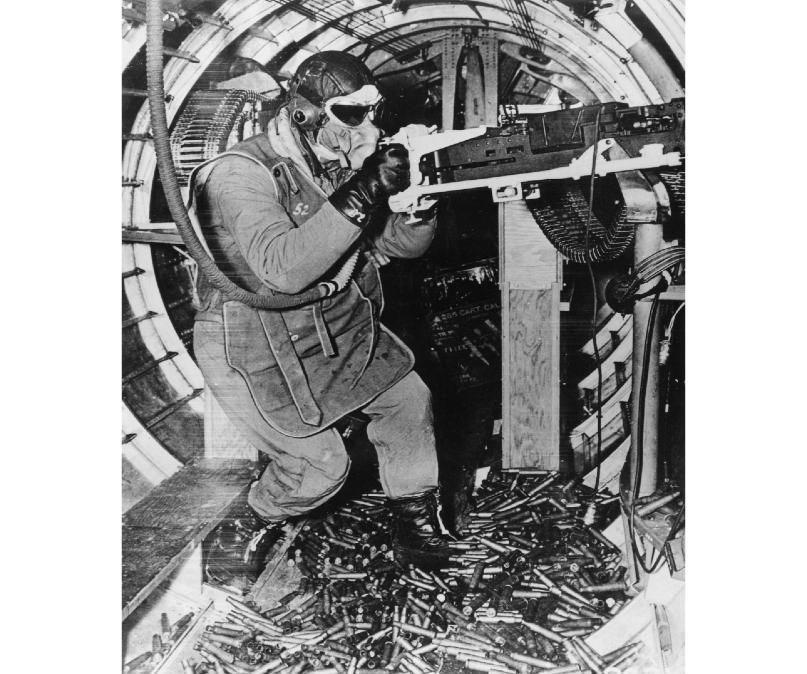
AAF waist gunner, equipped with typicalflight gear, in action aboard a B-17 bomber duringthe winter of 194344 (courtesy U.S. Army).
United States Army Aviators Equipment, 19171945
C.G. SWEETING

McFarland & Company, Inc., Publishers
Jefferson, North Carolina
Also by C.G. SWEETING
United States Army Aviators Clothing, 19171945 (McFarland, 2015)
This book is a republication of Combat Flying Equipment: U.S. Army Aviators Personal Equipment, 19171945 (Washington, D.C.: Smithsonian Institution, 1989).
LIBRARY OF CONGRESS CATALOGUING DATA ARE AVAILABLE
BRITISH LIBRARY CATALOGUING DATA ARE AVAILABLE
e-ISBN: 978-1-4766-1946-0
2015 C.G. Sweeting. All rights reserved
No part of this book may be reproduced or transmitted in any form or by any means, electronic or mechanical, including photocopying or recording, or by any information storage and retrieval system, without permission in writing from the publisher.
On the cover: Air Corps fighter pilot in winter flying outfit, late 1940 (Rudy Arnold Collection, NASM)
McFarland & Company, Inc., Publishers
Box 611, Jefferson, North Carolina 28640
www.mcfarlandpub.com
Contents
Preface
Seven decades have passed since the end of World War II, and we are still learning about the tremendous effort that was required to achieve final victory over the Axis powers. We know now that the margin between victory and defeat in that complex world wide struggle was often narrower than many realized at the time.
The campaigns and contributions of the great commanders, air aces, and other heroes have been well documented; often overlooked are the important but lesser known technical accomplishments that made victory possible and laid the groundwork for postwar progress. How American airmen became the best clothed aviators of any air force during the war is documented in my book United States Army Aviators Clothing, 19171945. This companion volume is intended to describe the development and use of the many types of individual life-support equipment, a Herculean task that had a direct bearing on the efficiency of Americas air arm and the successful outcome of the conflict.
To appreciate fully the significance of this accomplishment, we must go back to World War I. The many difficulties and problems encountered in providing flight materiel for Army flyers, in an era of rapidly changing technology, continued through the 1920s and the decade of the Great Depression. The events of the hectic World War II years are, by comparison, a success, but one that was achieved only through the dedicated efforts of the many unsung heroes of the Army Air Forces, the medical profession, the scientific community, and American industry.
It will be noted that many of the items of personal equipment in service during World War II were actually developed long before the United States entered the conflict. It is, of course, impossible to include every item used by flying personnel of the U.S. Army Air Forces and its predecessor organizations: the Army Air Corps, Army Air Service, and Aviation Section, Signal Corps. The following chapters do cover the main types of individual flying gear used since World War I. Navigation instruments have been omitted, because of the great number involved, and the fact that these specialized devices have been described in numerous other publications. U.S. Navy, commercial, and foreign equipment has been mentioned when it influenced development overall, or Army materiel in particular. Space limitations unfortunately preclude a detailed description of the operation and use of most items. This information may be found in the references included in the notes and bibliography.
This study deals primarily with the personal equipment carried and used by the individual Army flyer, but some items of essential aircraft equipment have been included in order to make the history more complete and understandable. The entire oxygen apparatus, for example, including masks, regulators, and cylinders, is described because the components were designed to function as a part of a specific, overall system.
The preparation of this book involved the examination of many documents and photographs from a variety of sources. Little has been published concerning many important types of equipment, and I relied mainly on official manuals, technical reports, and studies. Also available for examination were actual specimens of flight materiel in collections, including that of the National Air and Space Museum (NASM), the U.S. Air Force Museum, and Robert Lehmacher of Burbank, Illinois. Unless otherwise indicated in the captions, the photos were produced originally by the United States Air Force (USAF) and its predecessors, and many were obtained from the NASM archives. Some photos of flyers armor were provided by the Army Ordnance Museum and the Army Natick Research and Development Laboratories. The U.S. Air Force Museum and the Office of Air Force History were, of course, invaluable sources of information and photos on every aspect of military aviation.
Most of the people responsible for the development of flight materiel before and during World War II received little public recognition for their effort. Unfortunately, many are now deceased and others could not be located, however, much of value was furnished by participants and experts in various fields.
I would like to extend my sincere thanks to the many people who provided information, assistance, and encouragement during preparation of this study. Lt. Col. Donald S. Lopez, USAF (Ret.), NASM Deputy Director, was particularly helpful during my research, because he actually used many of the items of personal equipment in air combat during World War II, and was always willing to share his flying experiences and intimate knowledge. Don kindly consented to review and comment on my manuscript. Robert Lehmacher, expert on survival gear and flight materiel in general, provided much valuable information for Chapter VI, and important advice on equipment of all kinds. Chapters VI and VII include photographs of items in his splendid collection. Col. A. Pharo Gagge, Ph.D., USAF (Ret.), of the Pierce Foundation, Yale University, was assigned to the Aero Medical Laboratory at Wright Field throughout the war, where he was involved in the development of many items of flying equipment. As the originator of pressure-breathing oxygen equipment for the Army Air Forces (AAF), his suggestions were very beneficial during preparation of Chapter II.
I especially appreciate the generous contributions of the following individuals, who furnished expert opinions, and valuable historical and technical material on a great variety of subjects: Jack Hilliard, curator, and Vivian White and Charles Worman of the Research Division, U.S. Air Force Museum; Bill Heimdahl, archivist, Office of Air Force History; Dr. Robert Smith, chief historian, USAF Logistics Command; and Kenneth Zimmerman, USAF Aerospace Medical Research Laboratory.
Particular thanks go to aviation pioneers Brig. Gen. Harold R. Harris, USAF (Ret.), Russell S. Colley, retired Goodrich engineer, and Ernest H. Schultz, Wiley Posts chief mechanic; also to several former AAF flyers who shared with me a wealth of wartime experiences: Brig. Gen. Charles E. Yeager, USAF (Ret.); Lt. Col. David Topton, USAF (Ret.); Warren Keating; Morgan Rawlins; Carl R. Thompson; Fred Huston; W. L. Warren; and the late Brig. Gen. Benjamin S. Kelsey, USAF (Ret.).
Next page
